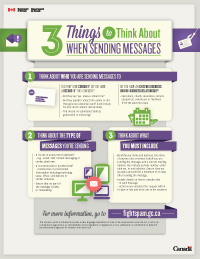3 Things to Think About When Sending Messages

3 Things to Think About
When Sending Messages
Sharing version (JPEG, 28 KB)
Print version (PDF, 234 KB)
- Think About Who You Are Sending Messages To
Did they give consent? Do you have a record of this consent?
- Did they say 'yes, please contact me'?
- Did they publish contact info online or did they give you a business card? (Look closely for any 'don't contact' instructions)
- This means no automated address generation or collecting!
Do you have an existing business or non-business relationship?
- Customers, clients, associates, donors, supporters, volunteers or members from the past two years.
- Think About the Type of Messages You're Sending
- Is it sent to an electronic address?
- E.g., email, SMS, instant messaging or similar platforms. - Is it commercial or promotional?
- Commercial or promotional information including marketing, sales, offers, solicitations or similar activities. - Ensure that no part of the message is false or misleading.
- Is it sent to an electronic address?
- Think About What You Must Include
- Identify your name and business, the name of anyone else on whose behalf you are sending the message, and a current mailing address. Also include a phone number, email address, or web address. Ensure they are accurate and valid for a minimum of 60 days after sending the message.
- Include details on how to unsubscribe
- In each message
- Action every unsubscribe request within 10 days or less and at no cost to the recipient.
For more information, go to fightspam.gc.ca
This resource, which is intended to provide a plain language explanation of some of the requirements under the Act, is not to be considered as legal advice, an interpretation of any legislation or regulations, or as a settlement or commitment on behalf of the Enforcement Agencies for Canada's Anti-Spam Law.